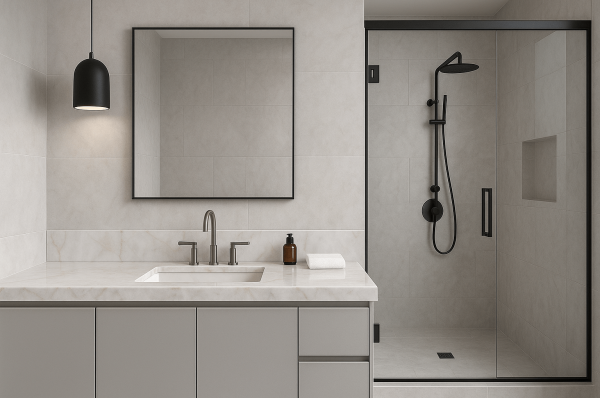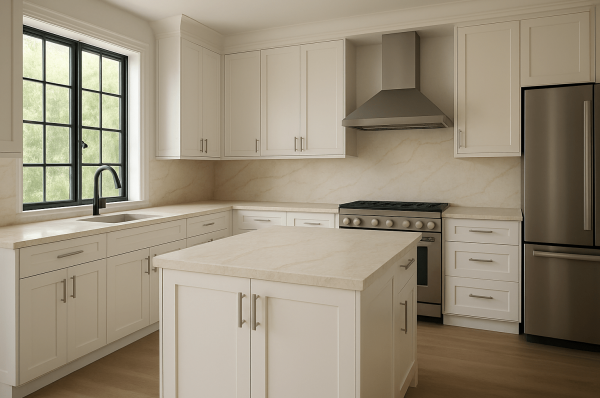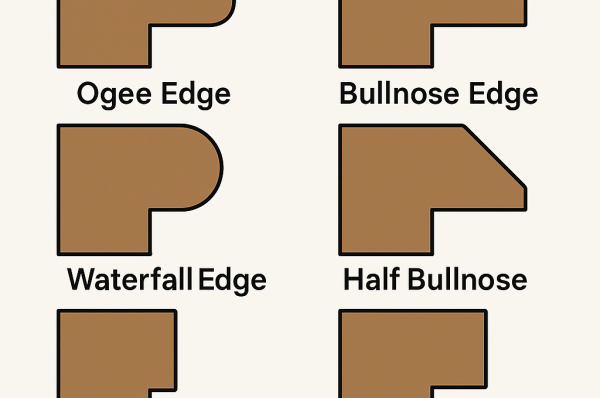The Style by Emily Henderson blog (written by Jess Bunge) highlights key kitchen design directions for 2025. The author cautions that bold, permanent choices should be made thoughtfully – “unless you know you’ll love it for 20 years maybe don’t,” she quips – but notes that each featured trend has “longevity” and is meant to inspire. Below we detail each trend’s defining elements, materials, color schemes and style influences, with examples from the article.
1. Rounded Cabinets
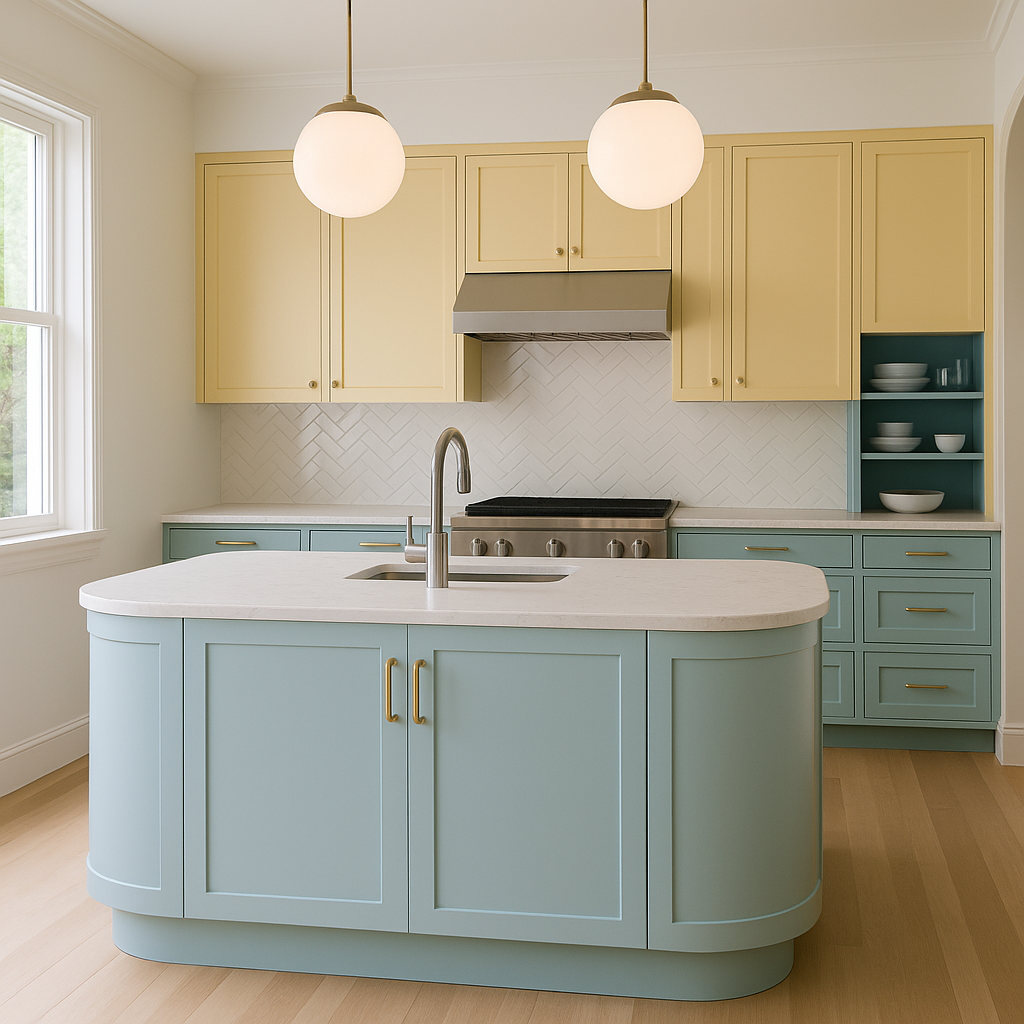
An elegant kitchen with a curved-edge island and cabinets in soft pastel blues and butter-yellow, blending modern and retro influences. Kitchens with rounded, curved cabinetry edges are a major trend. Rounded corners soften the typically hard geometry of kitchens, adding a playful, modern–yet–timeless feel. The article notes that glossy lacquered curves can “bring an effortless contrast to the harder angles” in a space (paired with natural wood grain and limewash plaster walls for balance). Styles range from modern to traditional: for example, a white-painted kitchen with curved-base cabinets and island looks elegant and custom, while a richly-colored design (Bidgood’s kitchen) uses rounded wood panels in light dusty blue and butter-yellow hues to give a retro-meets-modern charm. The overall palette for this trend tends toward soft neutrals or pastels (light blues, creams, pink-beiges) contrasted with warm wood tones. Rounded cabinets inject an organic, eye-catching element into an otherwise neutral kitchen, making it feel “very special” without sacrificing longevity.
2. Integrated “Stand-Alone” Cupboards
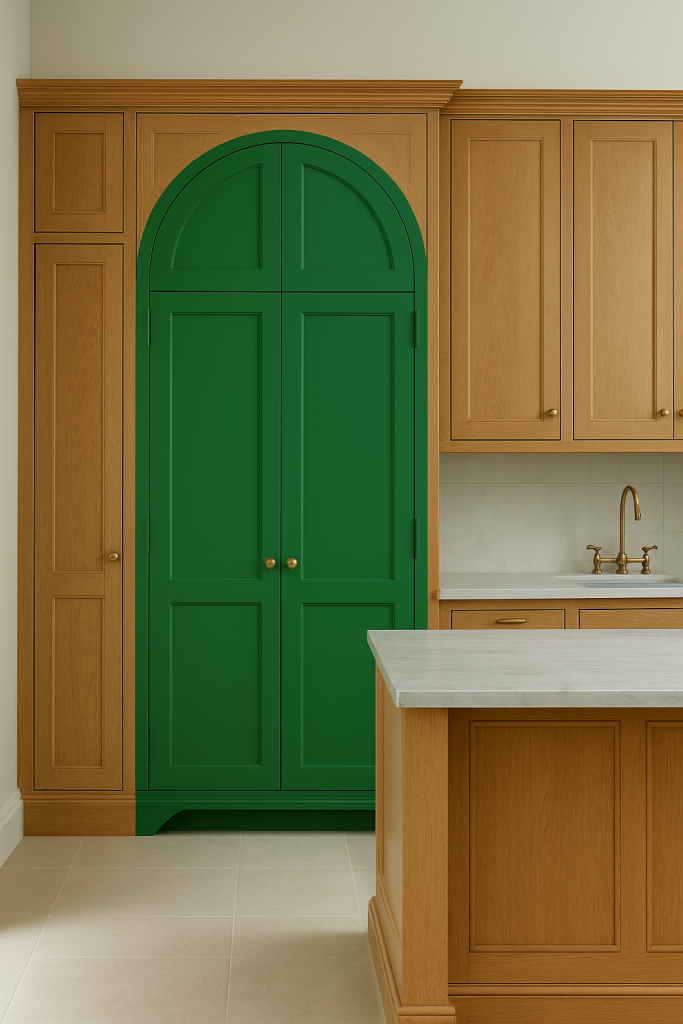
A kitchen where a bright green arched larder cabinet (hiding a refrigerator) is integrated into the wall of oak cabinets. This trend disguises appliances as built-in furniture. Large armoire- or hutch-like cupboard units are blended into the cabinetry, often hiding a fridge. In one example, a solid wood kitchen wall includes a bold green Dutch larder–style cabinet that actually contains the refrigerator: it “stands out” visually but “feels like it belongs”. Another example shows a pale olive cabinet facade that, at first glance, looks like pure storage but in fact houses appliances. These “cupboards” may feature arched tops or unique silhouettes, giving the kitchen a bespoke, antique-inspired feel. Materials are typically wood or painted millwork; muted earth tones and warm woods predominate, so the unit reads as furniture rather than bulky modern steel. As Bunge notes, this design brings “sweetness” to the kitchen through a mix of textures and aged finishes. Even DIY details like beaded-front cabinet doors can be incorporated to make the built-in unit feel handcrafted. Overall, integrated cupboards lend a furniture-like, almost vintage charm (think modernized armoire) while keeping utilitarian appliances fully concealed.
3. Pop of “Permanent” Color
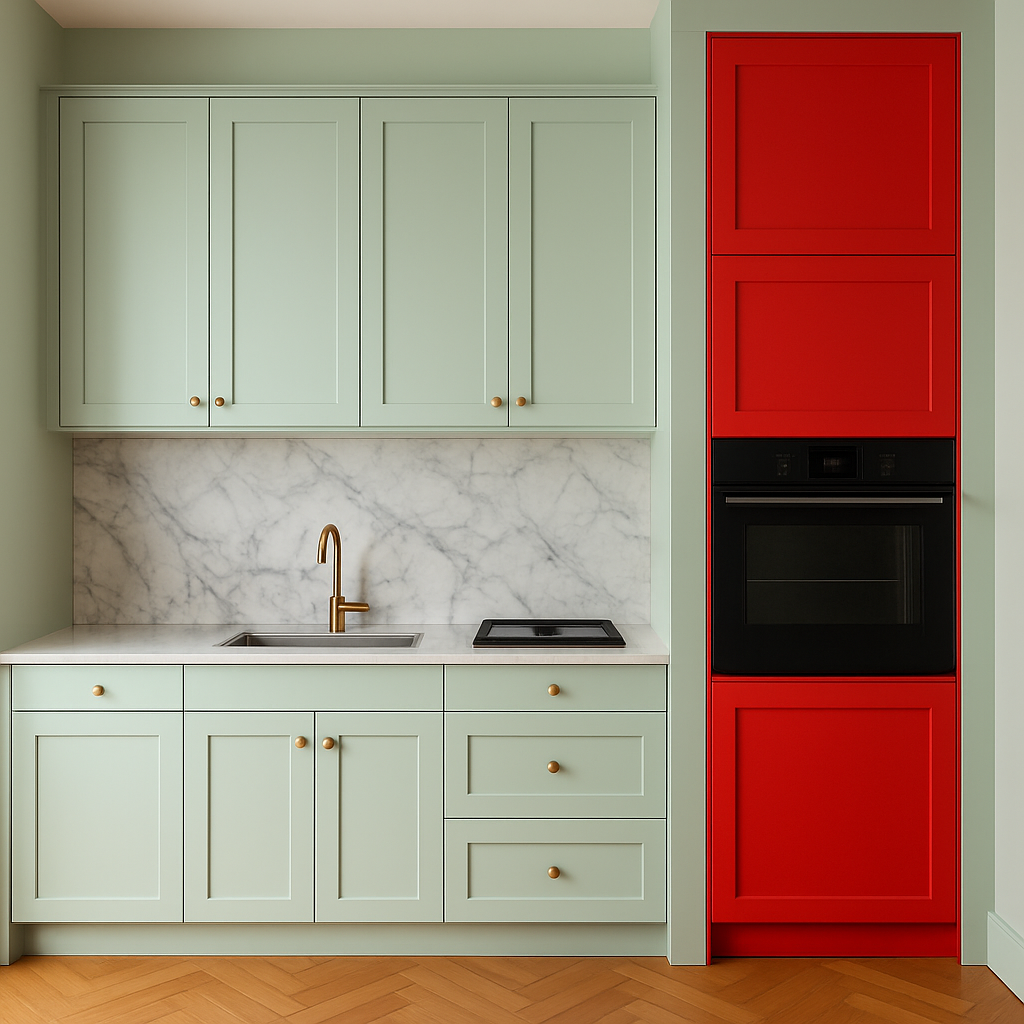
A mint-green kitchen with a striking bright-red built-in column; marble backsplash and herringbone wood floor ground the design. This trend is about injecting bold color into fixed elements of the kitchen (cabinets, walls, tile). The author admits caution with very bright palettes, but highlights several examples where a permanent splash – e.g. painted cabinets or tiled backsplash – transforms the space. In one kitchen, soft mint-green base cabinets and natural stone counter are made thrilling by one “pop” of bright cherry-red column and shelving; the kitchen would be pretty without it, but with that red “the whole space is taken to another level”. Another features a pop of baby blue (on a shelf or niche) that “puts a little extra electricity” into the room; baby blue is cited as a color “on fire” now yet timeless if used judiciously. Designers also use colorful tiles: for example, a kitchen peninsula clad in rich brick-red zellige tile adds eye-catching texture without overwhelming the white oak cabinets. Similarly, green glazed tile can highlight one wall as an “inviting, extra special” accent. In each case the palette mixes a mostly neutral or soft background (pale greens, wood, marble) with one saturated tone (red, blue, green) chosen for impact. Bunge emphasizes that even strong colors (emerald, brick red, royal blue) can behave almost like neutrals if balanced correctly.
4. Reeding Accents
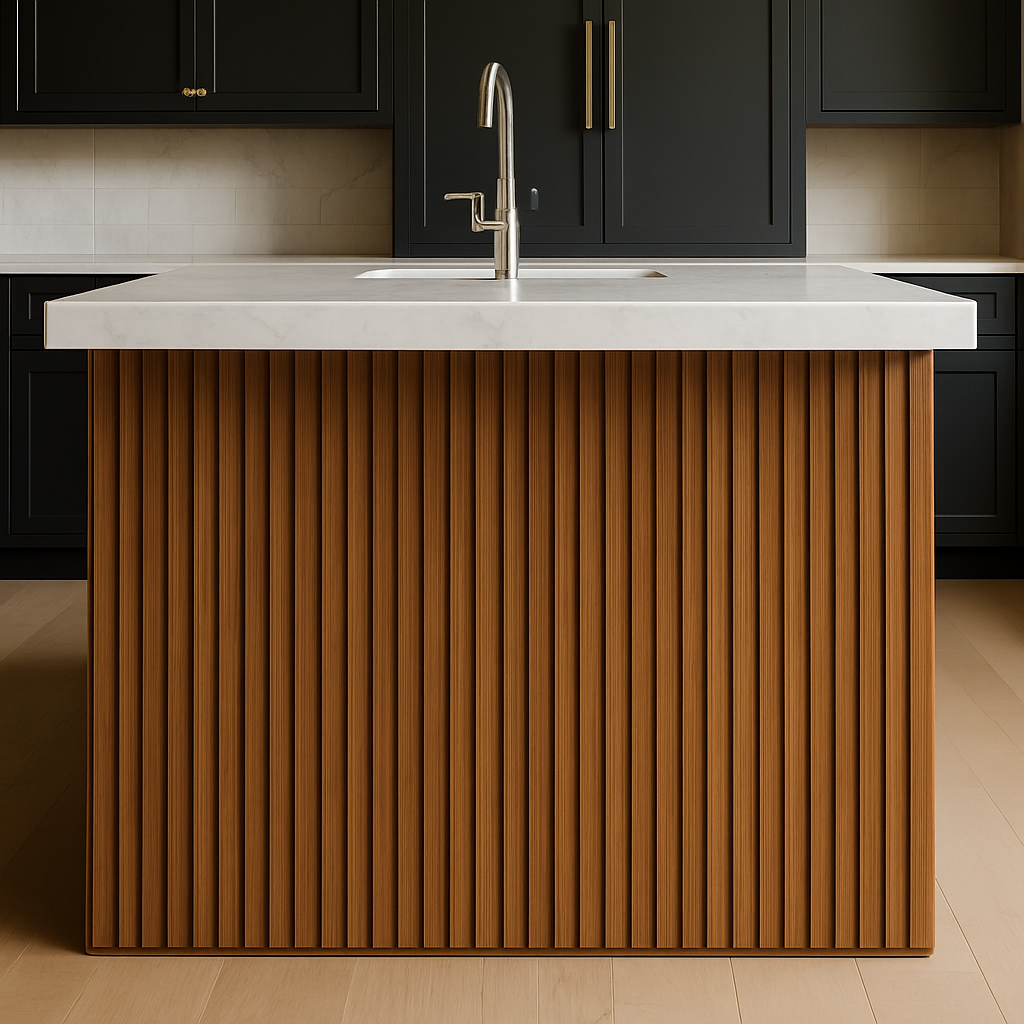
A luxurious kitchen island faced with vertical reeded wood panels, contrasting a white marble countertop and dark painted cabinets. “Reeding” means fluted or grooved surfaces, and it appears widely on islands, cabinetry panels and even tiles. The article notes that reeded panels add a “refined organic texture” to any style. For instance, a modern-luxe kitchen uses warm oak reeded cladding on the island’s curved base, contrasting its smooth white marble top and sleek painted cabinets. Another design (by POCO) applies ribbed detailing to both the island and surrounding cabinet faces – paired with a burgundy marble – creating an elegantly textural effect. Sarah Sherman Samuel’s kitchens show natural-wood reeded surfaces on island posts and cabinetry, which Bunge praises as “beautiful” and emotionally satisfying (“makes my eyes extremely happy”). Even backsplash tiles can mimic this look, as one pale-mosaic tile with a corrugated motif suggests. The palette here tends to stay warm and neutral (golden oak, cream, navy or black bases), letting the linear shadowplay of the grooves be the focal texture. Reeded wood accents bring an artful, tactile quality to a kitchen – a mix of mid-century-modern polish and handcrafted warmth.
5. Colorful Window Trim
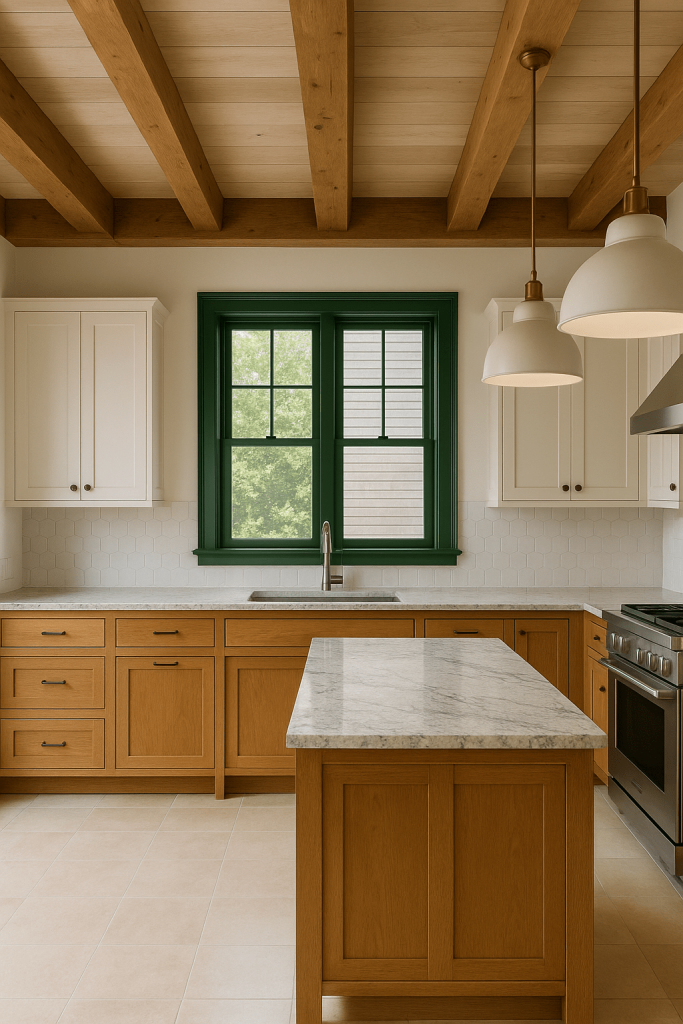
A kitchen with natural wood-paneled ceiling beams and deep green painted window frames and trim. This revived trend is to paint window frames, trims and even exposed beams in color to frame the view and define the space. (Emily Henderson first called this in 2020.) In practice, designers use earthy or jewel tones: for example, a wood-beamed kitchen has its window and beam trim painted matte black–green, which “brings the whole space together” in a modern-Mid-Century style. Another kitchen shows sage-green window casings contrasting with terracotta-red base cabinets. The author notes how the green trim “adds so much personality” – it also cleverly uses a cooler tint on the taller window frames so the room feels more open. Overall, the color palette is often nature-inspired (forest green, charcoal, burnt orange) chosen to complement the main cabinet colors. This small detail (painted frames) creates a surprisingly big impact, tying beams, cabinetry and decor together to define the room’s character.

